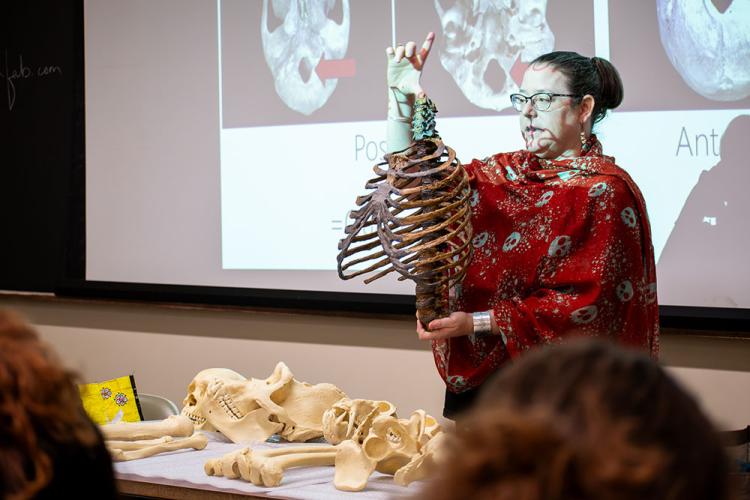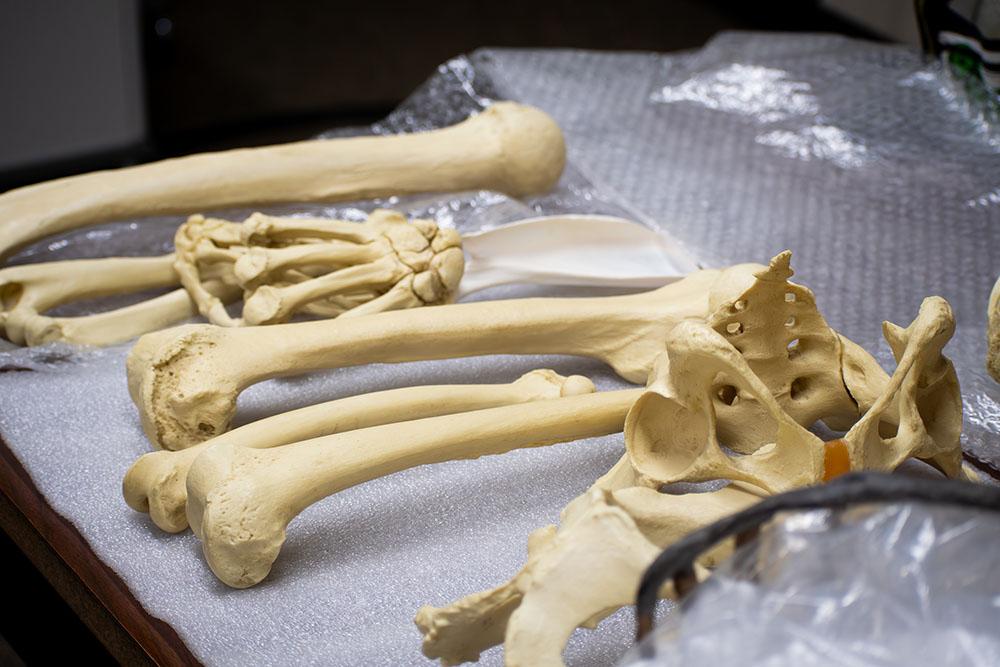
OHIO students get hands-on experience with fossil replicas

When Sabrina Curran, Ph.D., is preparing to teach a class, she packs only the essentials — a laptop, a coffee and a bag of bones.
But the bones aren’t Halloween decorations for her classroom. They are fossil replicas of early humans and primates used for teaching.
Curran, an associate professor of anthropology in the College of Arts and Sciences, said the replicas allow her students to learn more about themselves and their ancestral past.
“I bring as many bones as possible because the students really engage with them,” Curran said. “So, it kind of gets their attention when I’m unwrapping them at the start of class.”
Curran began teaching at Ohio University in 2014, and since then, fossils have played a central role in her hands-on approach to teaching.
When it comes to studying anthropology, she believes students can only learn so much from their textbooks.
“To see [fossils] in real life, you see this sort of connection that can be made in a way that'll never happen with a photograph,” Curran said. “It really gives you this more dynamic understanding of size of shape, or morphology.”
Over the summer, the University awarded the Department of Sociology and Anthropology roughly $25,000 to expand its fossil and human bone replica collection. Curran said the goal of the funding was to enhance the department’s undergraduate anthropology program.
Curran and her colleague Nancy Tatarek, Ph.D., an associate professor of anthropology, were instrumental in requesting the funds.
“I always wanted to have the best possible collection that we could afford, given that we’re a small midwestern university,” Tatarek said. “We were able to buy a pretty expensive update to what we had, which is amazing.”

Housed on the sublevel of Bentley Annex, the replica collection comprises more than 300 specimens, ranging from gorilla skulls to rare fossils like the hominin “Lucy.”
Previously, the department had gone more than a decade without expanding its fossil collection. Within this time, anthropologists made several groundbreaking discoveries, shedding more light on early human variation. “We were starting to become outdated,” Tatarek said. “It was really time, and I think what we got will be really impactful on our program.”
Using replicas is more ethical than studying real human remains and allows for greater accessibility in education, according to Curran.
“Fossils seem to be this thing that's put on a shelf and behind glass and museum,” Curran said. “We want to bring them to the students so that they actually have access to touch them.”
With the help of replicas, students can examine major discoveries made halfway across the world in the palm of their hands. “Having the specimens, which don't typically ever even leave the country they're from, available for students to look at, I mean, that's transformative,” Curran said.
Although the fossil collection is primarily studied by anthropology students, Curran said it makes an impact on students of all backgrounds. Some even decide to change their major.
One of these students is Carly Wisner, a junior studying anthropology with a focus in paleoanthropology. Wisner originally planned to attend medical school but had second thoughts after taking her first class in biological anthropology — where she studied fossils.
“I just saw myself just waiting to see those bones every single day,” Wisner said. “And I was like, ‘I have to, I have to switch to anthropology now.’”
For Wisner, anthropology provides a different way of viewing the world.
“Learning more about where we came from, it was important to me,” Wisner said. “I think it’s culturally important to know those types of things, especially with understanding our own biology.” After graduation, Wisner said she plans to pursue a doctoral program in paleoanthropology.
Curran believes access to the fossil collection is crucial to helping students like Wisner prepare for future careers.
“I treat any student in my class as if they're going into the field or going into the profession, either graduate student or professional work, or even moving forward, taking the knowledge of these things with them into their future,” Curran said.
